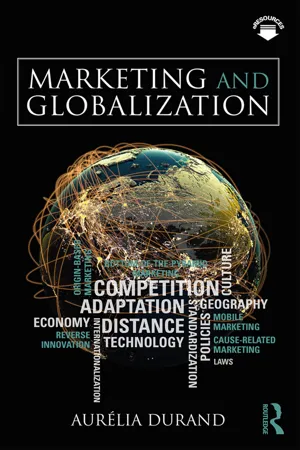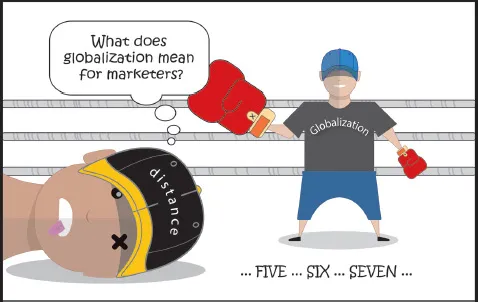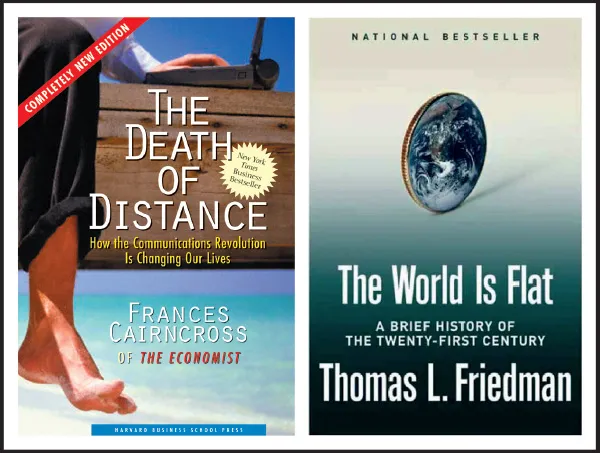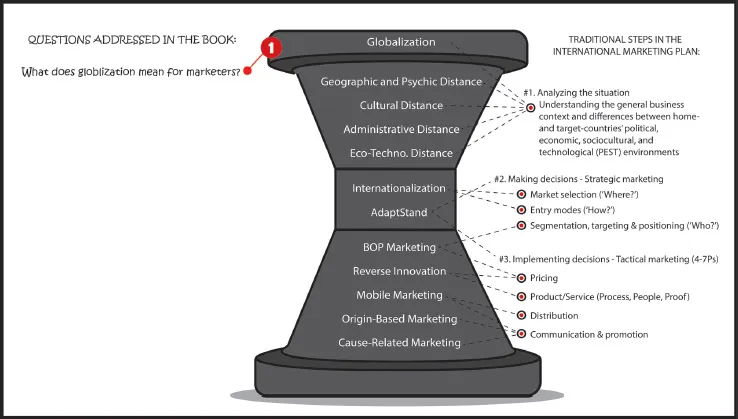![]()
1 Globalization
Table of Contents
- 1 Globalization
- Introduction: What Does Globalization Mean for Marketers?
- 1.1 Definitions
- 1.1.1 An Increase in Scale
- 1.1.2 Historical Perspective
- 1.1.3 In the Business World (Levitt)
- 1.2 Drivers
- 1.2.1 Politics and Integration
- 1.2.2 Technology and Convergence
- 1.3 Issues at Stake and Examples
- 1.3.1 Scope and Measurement
- 1.3.2 Corporate Examples: New Balance and Nike; Tata Motors; Nokia and Ericsson; Amazon, Apple, Google, and Facebook
- 1.3.3 Ambivalence of Outcomes
- Conclusion: For marketers, globalization means an increase in the scale of activities, supported by convergence and integration. It forces them to understand changing degrees of distance between markets and find new ways to differentiate from rising competition.
- References
Recommended Reading
- Levitt, Theodore (1983). The Globalization of Markets. Harvard Business Review, 61(3), 92–102
Figure 1.1 Illustrating Chapter 1
Introduction: What Does Globalization Mean for Marketers?
One of the ideas often associated with globalization is that distance represents less and less of an impediment to international business in general, and to international marketing in particular. In this view, the world is considered borderless and firms can market their products and services anywhere. Illustrated in Figure 1.2, examples of publications bearing this idea include Cairncross’s (2001) book entitled The Death of Distance 2.0: How Communication Revolution Will Change Our Lives, and The World Is Flat: A Brief History of the Twenty-First Century by Friedman (2005).
However, the question “Is distance dead?” still receives much attention. The notion of distance refers to more than just physical distance between two geographical locations. We are, in fact, talking about various kinds of differences between countries (cultural, administrative, economic, and technological) that are routinely studied for impeding, slowing down, or making international business more difficult, costly, and hazardous. Authors such as Ghemawat (2001) do not hesitate to claim that “distance still matters.”
Thus, asking the question “What does globalization mean for marketers?” leads us not only to wonder about firms’ internationalization and marketers’ skills and tools in this context (Chapters 2–3), but also to question whether distance in all its forms is actually increasing or decreasing worldwide (Chapters 4–7). We also use this question to set the stage for the study of marketing practices that have been developed in reaction to the globalization phenomenon (Chapters 8–13).
Figure 1.2 Books supporting the idea that “distance is dead”
The objectives of this chapter are to first define globalization and reflect on its origins. Second, we look at the drivers of globalization (politics and technology) and the important mechanisms through which globalization operates (integration and convergence). Finally, we discuss related issues (such as the scope and measurement of globalization, as well as conflicting opinions about its outcomes) and consider its impact on marketing decisions. Figure 1.3 indicates the position of this chapter in the overall book structure.
1.1 Definitions
This section addresses the following questions:
- What is globalization?
- When did globalization start?
- Who popularized the term in the business world?
1.1.1 An Increase in Scale
What is globalization? A great number of definitions of globalization exist and a variety of perspectives can be found in the literature. It is not easy to find a consensual definition, due to the complexity of the phenomenon. However, most authors agree on the fact that it is a process, not a “state.” Put simply, the following statements capture common ways of defining globalization: i) “This thing is everywhere now” (pointing to an increase in scale—or extent—of availability), ii) “Everything is becoming interrelated” (pointing to the mechanism of integration), and iii) instead of “everything is becoming similar” (pointing to the mechanism of convergence). In fact, integration and convergence are the reasons why “something” is found in an increasing number of places around the world. Distinguishing the causes from the actual phenomenon is important. Thus, we define globalization as the increasing scale of an object’s availability beyond the borders of its territory of origin. An object can be many “things.” Flows across national borders include exchanges (imports and exports) of goods and services, capital, information, ideas and technology, not to mention jobs (Griffin & Pustay, 2006). For this reason, the notion of borders is central to defining globalization, an inherently territorial phenomenon. Yet, a territory is not only geographic/tangible and its borders are not only at the national level. We address this point later on.
What are some formal definitions of globalization? Globalization has been described as “the increased mobility of goods, services, labor, technology and capital throughout the world” and add that, from the viewpoint of the firm, as “the process of doing something that is worldwide in scope” (Cateora, Gilly, & Graham, 2011, p. 11). Croucher (2004, p. 10) presents globalization as “the process of transformation of local or regional phenomena into global phenomena driven by a combination of economic, technological, socio-cultural and political forces.”
What is the common idea in these definitions? The notion of an increase in scale. The question concerning where can an object be found becomes central to defining globalization. If the answer is “worldwide,” then the object in question is “global.” Yet, since all things that are being “globalized” are not necessarily found everywhere, a finer definition is needed. Globalization is more about the “displacement” of an object, across borders, from a specific origin to a wider destination. One example of this increase in scale is the phenomenal growth of international trade of goods and services, as illustrated next.
Figure 1.3 Positioning Chapter 1 in the overall book structure
What data supports this idea of an increase in scale? The growth of exports of goods and services in absolute numbers (see Figure 1.4) shows a rather spectacular increase. For instance, exports value was tripled in twenty years (from ~2.5 trillion USD to ~7.95 trillion USD between 1980 and 2000) and then tripled again in the next fourteen years (reaching a peak of 24 trillion USD in 2014) (World Bank, 2016d). Yet, the phenomenon of increase in scale is best illustrated by the growth of exports as a ratio of the world’s GDP. Indeed, Figure 1.5 indicates a sharp increase in the proportion of value represented by exports compared to the overall value created in the world (measured by all countries’ cumulated GDP). It has more than doubled in the 1960–2015 timeframe, increasing from ~12 percent to ~29 percent in 2015 (World Bank, 2016a).
What could be other examples of “things” that have been displaced to a larger scale? For instance, do you, like Levitt (1983), think that pizza and jazz are good examples of the globalization of markets? It is safe to say that you can eat pizza (originally from Italy) and listen to live jazz (originally from the US) in any major city around the globe. But can you do so in smaller towns? Or in rural areas of East-Asian countries? Probably not. Another example would include celebrations; fifteen years ago, Halloween was still a very North American celebration. However, nowadays, European children and teenagers increasingly dress up and trick-or-treat on October 31 every year. Does it mean that this celebration has been globalized? Yes. Does it mean that it is now celebrated everywhere? No. We also often hear about various events that used to be contained within national or regional borders and that have now spread at a much larger scale. Examples of these types of events include financial crises and epidemics, etc.
What is an important observation that can be made based on these examples? The point is that the scale to which “something” is available (or present) far away from its place of origin varies. Its presence can be either extensive or moderate. What matters in defining globalization is the expanding scale of that presence. Another compelling example is to count the number of countries in which “something” must be present to be considered “global.” Again, the purist community on globalization would say that that “something” must be present “worldwide.” But hold that thought for a minute. First, we must ask ourselves the following question: how many countries are there in the world? Depending on the way we recognize sovereign countries, there is a total of between 180 and 220 countries in the world. The United Nations was made up of 193 Member States, as of 2018 (UN, 2018).
So, from which number of countries can “something” be considered global? Is it really 190 and not below? What if Starbucks only sells in about seventy countries (Starbucks, 2017)—should it not be considered a global company? There is no easy answer. The industry of fast-moving consumer goods (FMCG) flaunts multinational corporations (MNCs) (e.g., Nestlé, Unilever, and Coca-Cola) that sell their products in more than 150 countries. In contrast, the retailing industry is proud of its multinational giants, like Carrefour or Walmart, even though they operate in only about forty countries. As such, there is no consensual rule about how extensive the scale must be to be characterized as globalization. The increased scale of “where” products (or any other object) are made available is what matters in defining globalization. Before turning to integration and...



